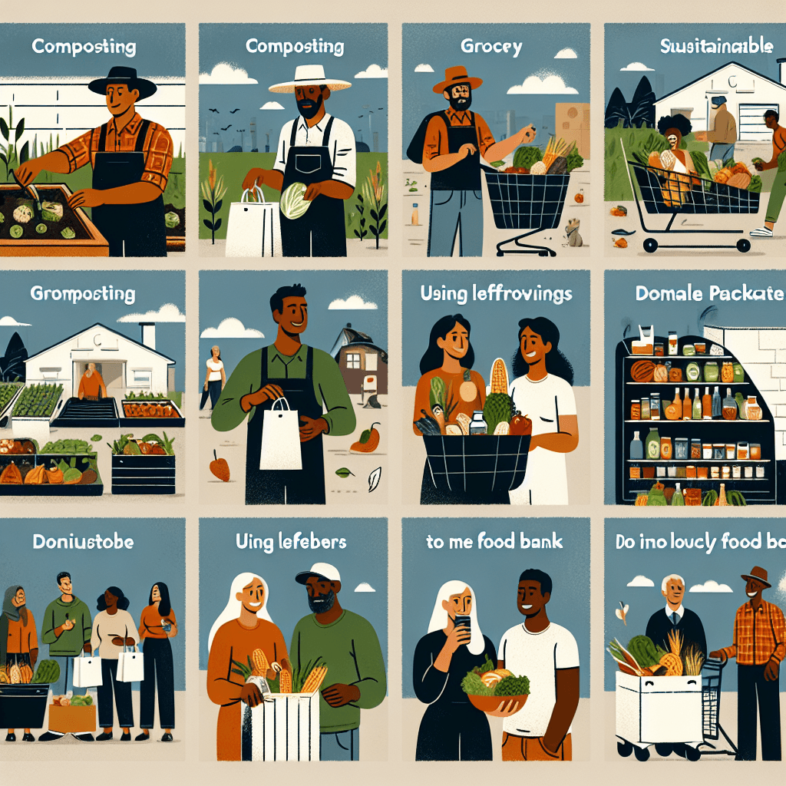Every year, approximately 1.3 billion tons of food are wasted globally, contributing to economic losses and environmental degradation. This article explores the way to food waste success via innovative strategies and community efforts aimed at combating food waste and highlights the role of women in leading this essential charge.
What You Will Learn
- Food waste accounts for around one-third of all food produced, severely impacting both the economy and the environment.
- Technology plays a crucial role in reducing food waste through apps, smart inventory systems, and platforms that connect surplus food with those in need.
- Countries like Denmark showcase effective national campaigns and regulations aimed at halving food waste by 2030.
- Community initiatives, such as food sharing platforms and gleaning programs, empower individuals to actively participate in reducing waste.
- Collaborative efforts among government, businesses, and nonprofits are essential for creating impactful food waste reduction strategies.
- Emerging technologies, including AI and smart sorting on recycling lines, are critical for optimizing food distribution and minimizing surplus.
- Individuals can make a difference by planning meals, storing food correctly, and composting scraps to reduce waste at home.
- Engaging in local initiatives, such as volunteering and donating excess food, strengthens community efforts against food waste.
Empowering Change: Women Leading the Charge Against Food Waste
The Global Challenge of Food Waste: An Urgent Call to Action
Understanding the Scale and Impact of Food Waste
Food waste is a massive issue affecting our planet. It’s estimated that about one-third of all food produced is wasted, which is around 1.3 billion tons each year. This not only depletes resources but also contributes significantly to climate change.
Why Food Waste Matters: Economic and Environmental Consequences
The effects of food waste extend beyond just losing food. Economically, it results in billions lost annually, affecting farmers, consumers, and the entire supply chain. Environmentally, wasted food produces greenhouse gases like methane when it decomposes in landfills, further harming our planet.
Innovative Solutions: How Technology is Transforming Food Waste Reduction
Game-Changing Tech Initiatives in Food Waste Management
Technology plays a crucial role in tackling food waste. Various initiatives harness innovation to reduce waste effectively, including:
- Food waste tracking apps that help consumers monitor what they throw away.
- Smart inventory systems for restaurants that predict food needs accurately.
- Online platforms connecting surplus food with those in need.
- New depackaging and separation equipment that no longer creates microplastic and nanoplastic.
Case Study: Denmark’s Comprehensive Approach to Food Waste
Denmark sets a strong example with its national campaign aimed at reducing food waste by 50% by 2030. This initiative involves:
- Strict regulations on food labeling to avoid confusion.
- Government funding for innovative food waste solutions.
- Awareness campaigns educating citizens on food preservation.
Success Stories from the United States: Pioneers in Food Waste Solutions
Spotlight on Imperfect Foods and Misfits Market
In the U.S., companies like Imperfect Foods and Misfits Market are changing how people think about produce. They focus on selling ugly fruits and vegetables that would typically go to waste. By doing this, they not only reduce waste but also promote sustainable eating habits.
How Technology is Reshaping Consumer Habits
Tech has significantly influenced how we consume food. Applications and websites help people:
- Plan meals effectively to minimize leftovers.
- Shop smarter, avoiding impulse buys that lead to waste.
- Share surplus food with friends and family, fostering community.
Hospitality Sector Innovations: Reducing Waste One Plate at a Time
Menu Engineering: The Art of Portion Control
Restaurants are finding new ways to control portions and minimize waste. Many are adopting practices such as:
- Offering smaller plate sizes.
- Implementing “build your own” meal options.
- Tracking waste to adjust menu offerings.
Collaboration with Food Banks: A Win-Win Strategy
Many hospitality businesses are partnering with local food banks to address waste. This collaboration not only helps feed the needy but also:
- Reduces disposal costs for restaurants.
- Promotes community goodwill.
- Raises awareness about food insecurity.
Community Initiatives: Grassroots Efforts to Combat Food Waste
The Rise of Food Sharing Platforms and Gleaning Programs
Grassroots movements are gaining momentum in addressing food waste. Food sharing platforms allow individuals to:
- Share excess food with neighbors.
- Participate in gleaning programs to harvest leftover crops.
Building Community Resilience through Resource Sharing
Communities are banding together to create a culture of sharing. These efforts include:
- Community fridges stocked with food donations.
- Workshops on food preservation techniques.
- Events promoting local food sustainability.

Comprehensive Strategies for Sustainable Food Waste Reduction
Collaborative Efforts: Building Partnerships for Greater Impact
Engaging Stakeholders: Government, Businesses, and Nonprofits
To tackle food waste effectively, collaboration is key. By bringing together various stakeholders, we can create a united front against waste. Here’s how different groups contribute:
- Government: Implements regulations and provides funding.
- Businesses: Innovate sustainable practices and reduce waste.
- Nonprofits: Raise awareness and support community initiatives.
Consumer Education: Empowering Individuals to Make a Difference
Raising awareness among consumers is crucial in reducing food waste. Education helps people understand the impact of their choices. Here are some effective educational strategies:
- Workshops and seminars on food preservation.
- Social media campaigns sharing tips on reducing waste/ recycling food waste success.
- Community events promoting local food initiatives.
Future Directions: Policy and Technological Innovations on the Horizon
Advocating for Policies that Support Waste Reduction
Effective policies can significantly reduce food waste at all levels. Advocacy is essential to push for changes that benefit everyone. Key policy areas to focus on include:
- Incentives for businesses that minimize waste.
- Stricter regulations on food disposal.
- Support for food recovery programs.
The Role of Emerging Technologies in Food Waste Solutions
Innovation plays a big role in solving the food waste crisis. New technologies help streamline food distribution and reduce surplus. Some promising technologies include:
- Apps that connect consumers with surplus food.
- AI systems optimizing inventory management.
- Smart packaging that extends shelf life.
Join the Movement: Steps You Can Take to Help Reduce Food Waste
Simple Actions for Individuals and Families
Every little action counts when it comes to reducing food waste. Individuals and families can make a significant impact. Here are some simple steps toward food waste success that you can take:
- Plan meals and make shopping lists.
- Store food correctly to avoid spoilage.
- Compost food scraps instead of throwing them away.
How to Support Local Food Waste Initiatives
Getting involved in local efforts can amplify your impact. Supporting nearby initiatives can help build a stronger community. Here are ways to participate:
- Volunteer at local food banks or gleaning programs.
- Donate excess food to charities.
- Attend community workshops on reducing waste.
Creating a Sustainable Future: The Path Forward
Integrating Food Waste Solutions into Daily Life
Incorporating waste reduction practices into daily routines makes a difference. Simple changes can lead to lasting habits. Consider these food waste success integration tips:
- Keep a food inventory and check it regularly.
- Teach children about food waste and its impact.
- Get creative with leftovers to minimize waste.
Inspiring a Global Movement for Change
Together, we can inspire others to join the fight against food waste. Sharing stories and successes can motivate action worldwide. Steps to inspire change include:
- Use social media to spread awareness.
- Share your food waste reduction journey with friends and family.
- Participate in global campaigns advocating for food waste solutions.
In the United States, several companies have also made strides in reducing food waste through technology-driven solutions. For example, Imperfect Foods and Misfits Market are two companies that specialize in rescuing “ugly” or surplus produce that would otherwise go to waste. By delivering these products directly to consumers’ doorsteps at discounted prices, these companies not only help reduce food waste but also provide affordable options for consumers while supporting farmers.
The following articles may also interest you:
Another success story comes from the hospitality industry, where hotels and restaurants have implemented innovative practices to minimize food waste. For instance, some establishments have adopted menu engineering techniques to optimize portion sizes and reduce leftovers. Others have partnered with local food banks or composting facilities to divert excess food from landfills.
Furthermore, community-driven initiatives such as food sharing platforms and gleaning programs have played a crucial role in reducing food waste at the grassroots level. These initiatives connect individuals and businesses with surplus food to those who are in need or can utilize it effectively. By fostering collaboration and resource-sharing within communities, these programs not only prevent edible food from being wasted but also promote social cohesion and support vulnerable populations. Read more about this in our beginners guide here.
Overall, these success stories demonstrate that effective solutions for reducing food waste require a multi-faceted approach involving collaboration among stakeholders, technological innovation, consumer education, and policy support. By learning from these examples and scaling up successful strategies, we can work towards a more sustainable future where resources are utilized efficiently, hunger is alleviated, and environmental impact is minimized.



